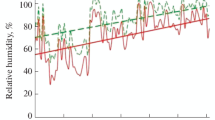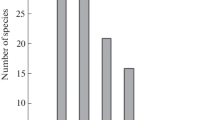Abstract
The composition of leaf pigments was studied in 32 species of gymnosperms. In 19 species belonging to four families, both evergreen and deciduous leaves turned to reddish brown in late autumn and winter. The red pigment detected in these leaves proved to be rhodoxanthin. The colouring was due to the disappearance of chloroplast pigments and the subsequent synthesis of rhodoxanthin. Neither qualitative nor quantitative differences were recognised in the chloroplast-derived pigments of green leaves between the species with and without the ability to produce rhodoxanthin. Unlike green leaves in which ca. 10% of total carotenoid content was α-carotene, reddish brown leaves scarcely contained α-carotene. Changes in pigment composition during the reddish colouring of leaves and their regreening were studied in detail and discussed.
Similar content being viewed by others
References
Arnon, D.I. 1949. Copper enzymes in isolated chloroplasts. Polyphenoloxidase inBata vulgaris. Plant Physiol.24: 1–5.
Cyronak, M.J., G. Britton, andK.L. Simpson. 1977. Rhodoxanthin, the red pigment ofEquisetum arvense sporophytes. Phytochemistry16: 612–613.
Goodwin, T.W.. 1952. The Comparative Biochemistry of the Carotenoids p. 13–14, 19, 35. Chapman & Hall Ltd London.
—. 1955. Carotenoids.In: K. Paech and M.V. Tracey, ed., Moderne Methoden der Pflanzenanalyse3: 294–296. Springer-Verlag, Berlin.
—. 1958. The changes in carotenoids and chlorophyll pigments in the leaves of deciduous trees during autumn necrosis. Biochem. J.68: 503–511.
—. 1965. Chemistry and Biochemistry of Plant Pigments p. 529–530. Academic Press, London.
Gribanovski-Sassu, O., L. Tuttobello, andF.H. Foppen. 1970. Carotenoids in some ultraviolet mutants ofEpicoccum nigrum Link. Arch. Mikrobiol.73: 216–223.
Hayashi, K. andY. Abe. 1955. Studien über Anthocyane. XXVII. Papierchromatographische Übersicht der Anthocyane im Pflanzenreich (II). Farbstoffe des roten Herbstlaubes. Bot. Mag. Tokyo68: 299–307.
Hida, M. 1958. Studies on anthocyanidin and leucoanthocyanidin in autumnal red leaves and green leaves of the conifers. Bot. Mag. Tokyo71: 425–429 (in Japanese).
— andK. Ida. 1964a Studies on a pink carotenoid in red, autumnal leaves of Taxodiaceae. Bot. Mag. Tokyo77: 458–461 (in Japanese)
—. 1964b. Studies on carotenoids of green and autumnal red leaves of Taxodiaceae. Bull. Osaka Women’s Univ., Ser. Nat. Sci. Domestic Sci.1: 35–37 (in Japanese).
Ishikura, N. 1973. The changes in anthocyanin and chlorophyll content during the autumnal reddening of leaves. Kumamoto J. Sci., Biol.11: 43–50.
Koch, W. 1976. Blattfarbstoffe von Fichte (Picea abies (L.) Karst.) in Abhängigkeit vom Jahresgang, Blattaler und-typus. Photosynthetica10: 280–290.
Kuhn, R. andH. Brockmann. 1933. Über Rhodoxanthin, den Arillis-Farbstoff der Eibe (Taxus baccata). Ber. dtsch. chem. Ges.66: 828–841.
Mackinney, G. 1935. Leaf carotenes. J. Biol. Chem.111: 75–84.
Moore, K.G. 1965. Senescence in leaves ofAcer pseudoplatanus L. andParthenocissus tricuspidata Planch. I. Changes in some leaf constituents during maturity and senescence. Ann. Bot.29: 433–444.
Peterson, P.J. 1963. The occurrence of rhodoxanthin in red-leaved seedlings ofAgathis australis Salisb. J. Exp. Bot.14: 1–9.
Reznik, H. 1955. Über das Anthocyan des Herbstlaubes. Naturwissenschaften42: 180–181.
Smith, J.H.C. andA. Benitez. 1955. Chlorophylls: analysis in plant materials.In: K. Paech and M.V. Tracey, ed., Moderne Methoden der Pflanzenanalyse4: 156–159. Springer-Verlag, Berlin.
Toyama, S. andK. Funazaki. 1971. Electron microscope studies on the morphogenesis of plastids. V. Concerning one-dimensional metamorphosis of the plastids inCryptomeria Leaves. Bot. Mag. Tokyo84: 123–136.
— andR. Ueda. 1965. Electron microscope studies on the morphogenesis of plastids. II. Changes in fine structure and pigment composition of the plastids in autumn leaves ofGinkgo biloba L. Sc. Rep. Tokyo Kyoiku Daigaku Sect. B12: 31–37.
Ueda, R. andT. Momose. 1968. Observations on the autumnal reddening of leaves in Gymnospermae and Pteridophyta in reference to their phylogenetic relationship. Sc. Rep. Tokyo Kyoiku Daigaku, Sect. B13: 199–205.
Whitfield, D.M. andK.S. Rowan. 1974. Changes in the chlorophylls and carotenoids of leaves ofNicotiana tabacum during senescence. Phytochemistry13: 77–83.
Wieckowski, S. andT.W. Goodwin. 1967. Studies on the metabolism of the assimilatory pigments in cotyledons of four species of pine seedlings grown in darkness and in light.In: T.W. Goodwin, ed., Biochemistry of Chlorplasts, II, p. 445–451. Academic Press, London.
Author information
Authors and Affiliations
Rights and permissions
About this article
Cite this article
Ida, K. Eco-physiological studies on the response of taxodiaceous conifers to shading, with special reference to the behaviour of leaf pigments. Bot Mag Tokyo 94, 41–54 (1981). https://doi.org/10.1007/BF02490202
Received:
Issue Date:
DOI: https://doi.org/10.1007/BF02490202




